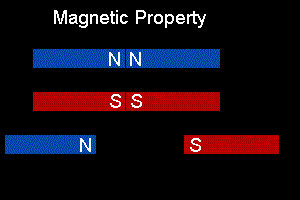|
ELECTRICITY and MAGNETISM
Please use our A - Z INDEX to navigate this site, or see HOME
|
|||||||||||
|
The Greeks knew the magnetic properties of the mineral lodestone, sometimes called Magnetite, as early as 600 B.C. Thales Miletus (640 - 540 B.C.), an early Greek mathematician and astronomer, was aware of the properties of attraction and repulsion of lodestone with like pieces of lodestone. He too knew if an electrostatic effect called the amber effect, that is, the attraction of bits of straw to an amber rod that had been rubbed with wool.
The laws of electricity and magnetism were closely studied by James Clerk Maxwell (1831 –1879), a Scottish physicist. Maxwell wondered why the physical laws were not symmetric when expresses in mathematical form. By applying the concept of symmetry, he found an additional law, which completed the equations of electromagnetism in 1865.
Maxwell studied these equations and discovered that, according to the equation, light is made up of electromagnetic waves. The theoretical fact that electromagnetic waves of radio frequency are likely led to experiments in which radio waves were generated and detected. This discovery opened up a new era of wireless communication and in due time brought us commercial radio and television and a host of other devices. Many of these practical developments will be described in this section.
ELECTRIC CHARGE
Electric
is a basic quantity. The property of electric charge is much the same
with certain subatomic particles, and experimental evidence leads us to
the conclusion that there are two types of charges. They are designated
as positive ( + ) and negative ( - ) for difference. All
matter, according to modern theory, is made up of tiny particles called atoms,
which are composed in part of negatively charged particles called electrons,
positively charged particles called protons, and neutral
particles that carry no electric charge, called neutrons.
The unit of electric charge is called the coulomb (C), and was named after Charles Coulomb, the French scientist who studied electrical effects. Electric charge is frequently designated by the letter q. A + q indicates that an object has an overflowing number of positive charges, or more proton that electrons. A - q indicates an overflowing of negative charge, or more electrons than protons.
When
charge "flows," or is in motion, we say we have an electric
current. Current is defined as the time rate of flow of electric
charge. It is measured in units of amperes, names after Andrè ampère
(1776-1836), one more early French investigator of electricity. One ampere
(A) is equivalent to a flow of one coulomb of charge per second. In
cymbol notation we relate electric current, commonly designated by the
letter I
KNOW YOUR
FORMULAS In the formula above, where I is the electric current, measured in amperes. And q is the electric charge flowing past a given point, measured in coulombs. And t is the time for the charge to move past the point, measured in seconds.
ELECTRICITY
The
effects created by moving charges give rise to what we generally call electricity. In order for charges to move, they must be acted upon by
positive or negative charges.
Consider the situation shown above. We start out with some unorganized charges and then begin to separate them. Very little work is needed to pull the first negative charge to the lift and the first positive charge to the right. When the next negative charge is moved to the left, it is repelled by the negative charge already there, so more works is desired. In a like manner, it takes more work to move the second positive charge to the right. As we separate more and more charges, it takes more and more work.
Instead
of speaking of electric potential energy, we usually speak of a
potential difference or more commonly, voltage. The voltage is defined
as the amount of work it would take to move a charge between two points,
divided by the value of the charge. That is, voltage is the work
per unit charge, or the electrical potential energy per charge.
KNOW YOUR
FORMULAS The volt (V) is the unit of voltage and is equivalent to one joule per coulomb. Voltage is caused by a separation of charge, once the charges are separated, a current can be set up, and we get electricity.
When
we have a current, it meets with some opposition by reason of collision
within the conducting material. The opposition to the flow of charge is
called resistance. The unit of resistance is the ohm (
KNOW YOUR FORMULAS
MAGNETISM
One of the first things we note in examining a bar magnet is that it has two region of magnetic concentration: poles at the ends of the magnet. We call these two poles north seeking N, and south seeking, S, since a compass needle was one of the earliest applications of magnetism. The N pole of a magnet, like a compass, points north, and the S pole points south.
That is, N-S, attract, and N-N or S-S poles repel each other. The strength of the attraction or repulsion relies on the strength of the magnetic poles. Furthermore, in a manner similar to Coulomb's law, the strength of the magnetic force is inversely proportional to the distance between the magnetic poles.
Each magnet produces a force on every other magnet. In order to discuss these force effects; we present the concept of a magnetic field. A magnetic field is a set of imaginary lines that indicates the direction a small compass needle would point if it were placed at a specific spot. If you are to look at a magnetic field, the arrows in the field lines indicate the direction in which a compass N pole would point. The closer together the field lines, the stronger the magnetic force is acting on the imaginary compass.
The
field concept too applies to the electric force. An electric field is a set of
imaginary lines that indicates the direction a small positive charge would
move if it were placed at a specific spot. The electric fields are indicated
in the diagram above for a single positive charge, a single negative charge,
and a positive and negative charge together. The last arrangement is called an
electric dipole because there are two poles involved.
The field concept too applies to the electric force. An electric field is a set of imaginary lines that indicates the direction a small positive charge would move if it were placed at a specific spot. The electric fields are indicated in the diagram above for a single positive charge, a single negative charge, and a positive and negative charge together. The last arrangement is called an electric dipole because there are two poles involved.
ELECTROMAGNETISM
The interaction of electrical and magnetic effect is known as electromagnetism. Electromagnetism is one of the most important concepts in physical science, and much of our current technology is directly related to this crucial intercourse. We can summarize the two basic principles of Electromagnetism as follows:
1. Moving electric charge creat magnetic fields.
2. A magnetic field may deflect a moving charge.
One of the most significant application of this principle is called an electromagnet. An electromagnet consists of a current-carrying coil of insulated wire wrapped about a piece of soft iron. At what time the current is turned on, a magnet field is created inside the coil. The soft iron is magnetized by this field and makes the magnetic field nearly 2000 times stronger. When the current is turned off, the iron loses nearly all of its magnetism.
The advantages of the electromagnet are numerous. First, it can be switched on and off. Second, the strength of the electromagnet can be controlled by the amount of current flowing in the wire. Third, reversing the current can reverse the poles of the magnet field.
Electromagnets are used in a variety of devices and appliances, such as doorbells and telephones, and in devices used for moving magnetic metals. The mechanism in a telephone receiver will serve as an illustration of one use.
When a telephone number is dialed, a circuit is complete by another telephone's bell. When the ringing phone is picked-up, the circuit between the speakers and receivers of the two telephones is completed. A telephone conversation consists of converting the sound waves to varying electric current. This varying current travels along the wire to the other telephone's receiver where it is converted back into sound waves.
The transmitter of a phone contains a diaphragm that vibrates because of the sound waves that are spoken. The diaphragm vibrates against a chamber that contains the carbon granules. As the diaphragm vibrates, the pressure on the carbon granules varies, that causes more or less electric resistance in the circuit. The resistance is low when the granules are presses together and increases while they spread apart. On account of Ohm's law this varying resistance causes a varying electric current to be transmitted.
Upon the receiver end there is an electromagnet and a permanent magnet, which is attached to a disk. The varying of electric current gives the electromagnet varying magnet strength. The electromagnet attracts the permanent magnet by a variable force. The inconstant force on the permanent magnet and disk causes the receiver disk to vibrate. This vibration sets up the sound waves that closely resemble the original sound waves, and the voice is heard at the other telephone.
ELECTRICAL SAFETY
Electrical safety for both people and property is an significant consideration is using electricity. For instance, in household circuits, as more and more appliances are turned on, more and more current flows and the wires get hotter and hotter. At what time too much current flows, the fuse gets so hot that it melts and acts as an open switch. The damaged fuse stops any current from flowing until the fuse is replaced.
A circuit breaker has the equivalent function as a fuse. When the current gets too high, the circuit breaker triggers a switch to open, halting any kind of current from flowing. When the trouble is repaired, the circuit breaker can be pushed in to close the switch, and current can again flow in the circuit.
Switches, fuses, and circuit breakers are always placed in the hot or high-voltage side of the line so that when they are opened, current flow is disconnected. However, fuses and circuit breakers may not always give safety from electrical shock. A hot wire inside an appliance or power tool may break loose and come in touch with a housing or casing, putting it at a high voltage. The fuse does not blow if there is not a large current flow, suchlike when being shorted to ground (zero potential).
You have presumably noticed that some plugs have one blade larger then the other and will only fit into a wall outlet in one way. Polarized plugs are an older type of safety mark. Being polarized or directional, one side of the plug is all the time connected to the ground side of the line. The casing of an appliance can be connected to ground by this means, with a like effect as the three-wire system. However, a dedicated grounding wire is better, because the polarized system depends on different components of the circuit being wired or connected properly.
An electrical shock can be very dangerous, and touching exposed electric wires should constantly be avoided. Numerous people are killed every year though electric shocks. The danger is proportional to the measure of electric current that goes through the body. Ohm's law as described below gives the amount of current going through the body.
Where
KNOW YOUR
FORMULAS A current of 0.001 A (amp) can be felt as a shock, and a current as low as 0.05 A can be fatal. A current of 0.1 A is almost always fatal.
The amount of current, as indicated, is very dependent on the body's resistance. The body's resistance varies considerably, mostly due to the dryness of the skin. Because our bodies are generally water, the skin resistance makes up most of the body's resistance.
A
dry skin will have a resistance as high as 500,000
Therefore, appliances such as radio should not be operated near a bathtub. Should a plugged-in radio happen to fall into a bathtub, then the whole tub, as well as the person in it may be plugged in to 110 V.
LINKS and REFERENCE
Tyndall: Faraday as Discovery: Identity of Electricities US Energy Department Statistics Read Congressional Research Service (CRS) Reports regarding Electricity Answers to several question of curious kids about electricity Illustrated view of how an American home's electrical system works How to save on your electricity bills A Comprehensive Collection of Franklin’s Electrical Works: The Electrical Writings of Benjamin Franklin, Created and Collected by Robert A. Morse (2004) Understanding Electricity and some Electronics in 10 minutes (Steve Rose, Maui)
The old Generating Station at Herstmonceux, if the oldest surviving example in the world, of electricity distribution to a whole village, featuring load levelling. The site is recorded at TheKeep, in Brighton, Sussex, as part of a Historic Environment Record (HER) maintained by East Sussex County Council.
This modest industrial complex is astonishing, not because it is an architectural gem, but because it has survived for so long, when it is constructed largely of wood. And it is so technologically advanced for such a small installation in the country.
Hundreds of historic buildings are at risk, because councils and competing developers want them demolished, or refuse point blank to recognize the value of a historic asset, where it potentially limits their own property development plans. In addition, the law is one-sided, favouring developers, where it is not a criminal offence under the Party Wall Act 1996, to excavate close to a historic asset, without giving Notice, or carrying out a survey, such as not to put monuments at risk.
|
|||||||||||
|
This
website is copyright © 1991- 2024 Electrick Publications. All rights
reserved. The bird logo |









